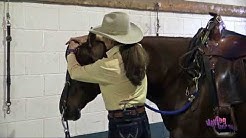Question:
Dear Julie,
I am currently schooling and riding in a D-ring snaffle bit. I want to start training for Western Pleasure. What kind of shank bit do you recommend for the transition?
Thanks,
Kim
Answer:
In most rule books, horses six years old and up are required to show Western in a curb bit. Horses five and under can be ridden two-handed in a snaffle. As the horse advances in his training and you are doing more advanced stuff, your horse will probably work better in the curb, provided you find the right bit for him.
First, it is important to understand the difference between curbs and snaffles; many people have misconceptions about this. It has nothing to do with the mouthpiece—being jointed doesn’t make it a snaffle. A snaffle is a “direct pressure” bit, meaning the reins are attached directly opposite the mouthpiece and there is a direct, pound-for-pound pressure on the horse’s mouth from a pull on the reins. A snaffle could have a solid mouthpiece and a bit with a joint in the mouthpiece but shanks is not a snaffle—it is a curb bit. Just because it is a snaffle does not mean it is mild and a curb is not necessarily harsh; many curb bits are milder and more comfortable for the horse than snaffles.
A curb bit has a shank on each side which drops down below the mouthpiece and the reins are attached below; a curb strap (or chain) behind the chin creates leverage. It is the ratio between the top part of the shank (the “purchase”) and the bottom part that dictates the amount of leverage; a 1:2 ratio means that for every one pound of pull, the horse gets two pounds of pressure. In general, the curb bit can give you more braking ability. If it has a mild port (a rise in the mouthpiece) it may be more comfortable for your horse than a straight snaffle; the port gives a relief of pressure from the tongue.
You should always ride two-handed in a snaffle. With a curb bit, you may be able to ride one handed or two. If the curb bit is one solid piece, riding two-handed does not do any good because if you pick up on one rein, the whole bit moves. If the bit has articulation from side to side, like Myler bits do, you can ride two-handed when you need to and you are able to work off the sides of the horse’s mouth, giving you greater training ability.
Most likely the bit I would recommend for your horse is the Myler MB04 with an HBT shank and a leather curb strap; it is an excellent bit to transition from snaffle to curb. The HBT shank is quite short and has very little leverage. The MB 04 mouthpiece has a small port which gives the horse a little relief of pressure for his tongue and is more comfortable for him than the D-ring snaffle you are using now.
Any time you change the bit on a horse, give him a little time to get used to the new feel in his mouth. Any different shape will be very noticeable for him, just like it would be for us, and he’ll need 15-20 minutes to get used to the new feel before you start doing anything with the reins. After that, you can start riding as you normally would, being aware that there is now a little leverage, so you may not need as much pressure from your hands.
Start out riding two-handed with a lightly loose rein as the horse gets used to the new bit. Practice keeping your hands closer and closer together and moving them as one; that’s how you’ll work up to riding one-handed. Even once you are riding one-handed, do not hesitate to go to two hands as needed to keep the horse correct (in the right frame and arc). Of course, in the show ring you’ll have to ride with one hand, but when training always keep the horse correct and use two hands as needed.
The Myler bits that I most frequently recommend to people are listed on this web page, along with an explanation of what type of horse I would use them on http://www.juliegoodngiht.com/myler Also, there’s a great new 4-part online free video series from Dale Myler that you can find a link to on the main page of my web site. He talks about his bits and explains the transitions well: http://juliegoodnight.com
Good luck with your horse and I hope your transition to a curb bit is easy!
Good luck!
–Julie Goodnight Trainer and Clinician

